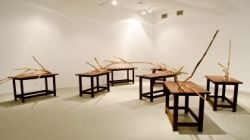
Avital Cnaani / Judy Chicago
Avital Cnaani
Born on Kibbutz Cabri, 1978
Lives and works in Tel Aviv
Avital Cnaani's work is composed of a group of tables pushed into a corner, like a herd of abandoned objects/creatures. Lying across the tables is an object resembling the body of a dead bird - a still-life representing a memento mori (an exhortation to remember death). What Cnaani takes from Judy's Chicago's festive table is the moment after - after the dinner party, when all that is left are its remains.
Judy Chicago
Born in Chicago, USA, 1939
Judy Cohen was born in Chicago into a family whose paternal genealogy boasts a lineage of important rabbis, including the Vilna Gaon. Following the death of her father and her first husband, she decided to abandon her previous family names - Cohen, Gorewitz - which belonged to the men in her life. The owner of her gallery called her "Judy Chicago" due to her strong local accent, and so she officially changed her last name to that of her native city. As a young artist, Chicago painted abstract, minimalist paintings and created performances. Later on, she became interested in expressions of sexuality and womanhood in art. In 1970, she offered an art course for women only at the University of California, which evolved into the first American program for feminist art. Together with Miriam Schapiro, she was involved in organizing the first exhibitions of women's art, including Womanhouse - an ongoing art installation by women (Los Angeles, 1972).
In 1974, she began creating her most famous work, The Dinner Party. Some 400 assistants, most of them women, contributed to the project by performing research and by sewing, embroidering, and designing the glassware and china. After it was presented at the San Francisco Museum of Modern Art, this work traveled worldwide and was exhibited in a range of museums. Since 2007, it has been on permanent display at the Brooklyn Museum in New York.